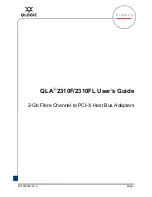
Ethernet Port Commands
Page 208
7710 SR OS Interface Configuration Guide
group. The accounting policy defines which queue counters are collected and to which accounting file they
will be written.
A queue group does not have an administrative shutdown or no shutdown command. A queue group is
considered to be always ?p?once created.
When creating a queue group, the system will attempt to allocate queue resources based on the queues
defined in the queue group template. If the appropriate queue resources do not currently exist, the queue
group will not be created. Ingress port queue groups do not support the shared-queuing or multipoint-shared
queuing behavior.
When the queue group is created on a LAG (Link Aggregation Group), it must be created on the primary
port member. The primary port member is the port with the lowest port ID based on the slot, MDA position
and port number on the MDA. A queue group created on the primary LAG port will be automatically created
on all other port members. If a new port is being added to a LAG with an existing queue group, the queue
group must first be created on the port prior to adding the port to the LAG. If the LAG queue group has
queue overrides, the queue overrides must also be defined on the port queue group prior to adding the port to
the LAG.
A port queue group cannot be removed from the port when a forwarding class is currently redirected to the
group. All forwarding class redirections must first be removed prior to removing the queue group.
Default
none
Parameters
group-name —
The group-name parameter is required when executing the port queue-group command. The
specified group-name must exist as an ingress or egress queue group template depending on the ingress
or egress context of the port queue group. Only a single queue group may be created on an ingress port.
Multiple queue groups may be created on an egress port.
create —
Keyword used to associate the queue group. The
create
keyword requirement can be enabled/
disabled in the
environment>create
context.
agg-rate-limit
Syntax
agg-rate-limit kilobits-per-second
[
queue-frame-based-accounting
]
no agg-rate-limit
Context
config>port>ethernet>access>egr>qgrp
config>port>ethernet>access>ing>qgrp
config>port>ethernet>network>egr>qgrp
Description
This command defines the maximum total rate of all egress queues in this queue-group.
If a port scheduler is not defined on the egress port, the queues are allowed to operate based on their own
bandwidth parameters.
The
no
form of the command removes the aggregate rate limit from theconfiguration.
Parameters
agg-rate —
Defines the rate, in kilobits-per-second, that the maximum aggregate rate the queues on the port
can operate.
Values
1 — 40000000, max
Summary of Contents for 7710 SR SONET
Page 6: ...Page 6 7710 SR OS Interface Configuration Guide Table of Contents...
Page 8: ...Page 8 7710 SR OS Interface Configuration Guide List of Tables...
Page 10: ...Page 10 7710 SR OS Interface Configuration Guide List of Figures...
Page 14: ...Preface Page 14 7710 SR OS Interface Configuration Guide...
Page 16: ...Getting Started Page 16 7710 SR OS Interface Configuration Guide...
Page 18: ...Page 18 7710 SR OS Interface Configuration Guide Configuration Notes on page 107...
Page 166: ...Service Management Tasks Page 152 7710 SR OS Interface Configuration Guide...
Page 354: ...Multi Chassis Redundancy Commands Page 328 7710 SR OS Interface Configuration Guide...
Page 494: ...Standards and Protocols Page 494 Standards and Protocols...
Page 496: ...Index Page 496 7710 SR OS Interface Configuration Guide...
















































